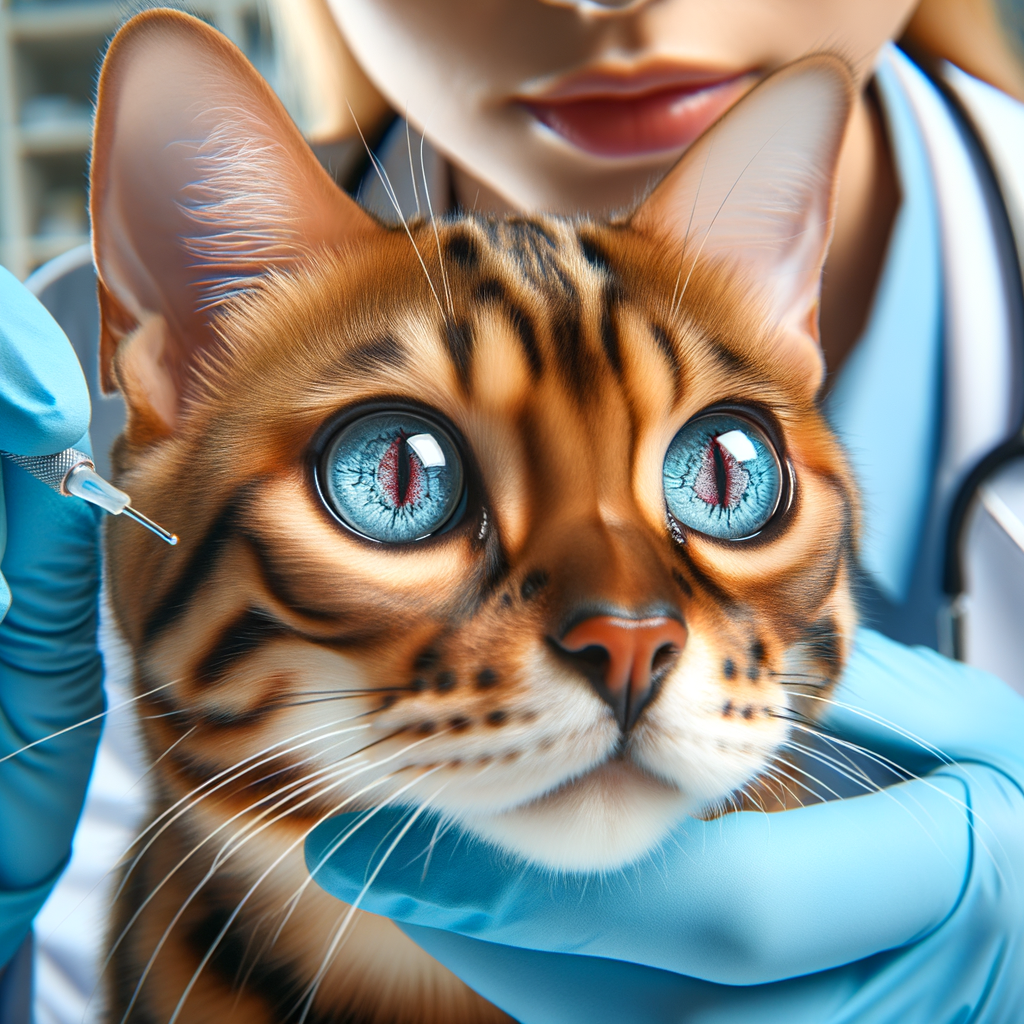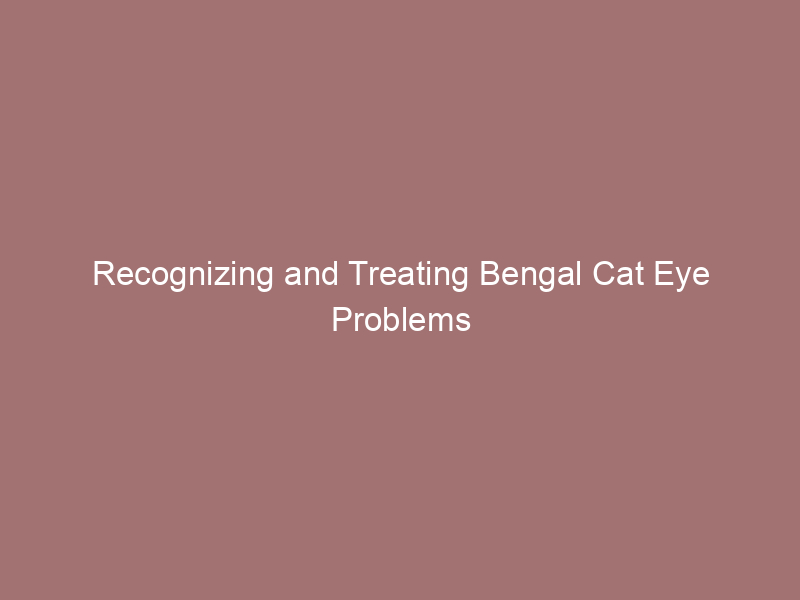
Introduction to Bengal Cat Eye Health
Bengal cats are known for their striking appearance and playful nature. However, like all pets, they need proper care to stay healthy. In this section, we will discuss the importance of eye health in Bengal cats, common eye issues they may face, and signs of healthy eyes.
- Importance of eye health in Bengal cats: Clear vision helps them navigate their environment, play, and hunt. Poor eye health can lead to discomfort, pain, and even blindness.
- Common Bengal cat eye issues: Bengal cats can suffer from various eye problems. Some common issues include conjunctivitis (pink eye), cataracts, and glaucoma. These conditions can cause redness, swelling, and discharge from the eyes.
- Signs of healthy Bengal cat eyes: Healthy Bengal cat eyes are bright, clear, and free from discharge. The pupils should be of equal size, and the cat should not squint or rub its eyes frequently. Regular check-ups with a vet can help ensure your cat’s eyes remain healthy.
Recognizing Bengal Cat Eye Problems
Common Bengal Cat Eye Infections
Eye infections in Bengal cats can be quite common. Knowing the signs and symptoms can help you catch these issues early and get your cat the treatment they need.
- Conjunctivitis in Bengal cats: Conjunctivitis, also known as “pink eye,” is an inflammation of the conjunctiva, the tissue lining the eyelids and covering the white part of the eye. Symptoms include redness, swelling, and discharge. If you notice these signs, consult your vet.
- Corneal ulcers in Bengal cats: Corneal ulcers are open sores on the cornea, the clear front part of the eye. They can be caused by injury, infection, or other eye problems. Symptoms include squinting, excessive tearing, and visible cloudiness or spots on the eye. Immediate veterinary care is essential.
- Uveitis in Bengal cats: Uveitis is an inflammation of the uvea, the middle layer of the eye. It can be caused by infections, trauma, or immune system issues. Symptoms include redness, pain, and sensitivity to light. Uveitis can lead to serious complications if not treated promptly.
Recognizing these common eye infections early can make a big difference in your Bengal cat’s health. Regular check-ups and prompt veterinary care are key to keeping their eyes healthy.
Bengal Cat Eye Discharge
-
Identifying Abnormal Eye Discharge
Healthy Bengal cats may have a small amount of clear discharge. However, if the discharge is yellow, green, or thick, it could be a sign of a problem.
Look for other signs like:
-
- Redness around the eyes
- Swelling
- Frequent blinking or squinting
-
Causes of Eye Discharge in Bengal Cats
There are several reasons why your Bengal cat might have eye discharge. Some common causes include:
| Cause | Description |
|---|---|
| Infections | Bacterial or viral infections can lead to eye discharge. |
| Allergies | Dust, pollen, or other allergens can cause eye irritation. |
| Injuries | Scratches or foreign objects in the eye can result in discharge. |
-
When to Seek Veterinary Help
- Discharge that lasts more than a few days
- Changes in eye color or cloudiness
- Behavioral changes like lethargy or loss of appetite
Bengal Cat Vision Problems
-
Signs of Vision Problems in Bengal Cats
- Frequent bumping into objects
- Reluctance to jump or climb
- Cloudy or hazy eyes
- Excessive blinking or squinting
- Unusual eye movements
-
Causes of Vision Problems in Bengal Cats
- Genetic disorders: Some Bengal cats inherit eye conditions from their parents.
- Infections: Eye infections can damage the eyes if not treated promptly.
- Injuries: Physical trauma to the eyes can result in vision loss.
- Aging: Older cats may develop cataracts or glaucoma.
- Diseases: Conditions like diabetes can affect a cat’s vision.
-
Treatment Options for Vision Problems
- Medications: Antibiotics or anti-inflammatory drugs can treat infections and reduce swelling.
- Surgery: Procedures like cataract removal can restore vision.
- Environmental adjustments: Making your home safer by removing obstacles can help your cat navigate better.
- Regular check-ups: Frequent visits to the vet can help catch and treat problems early.
Treating Bengal Cat Eye Problems
Bengal Cat Eye Treatment
- Home remedies for minor eye issues:
For minor eye problems, you can try some simple home remedies. Clean your Bengal cat’s eyes with a soft, damp cloth. Use saline solution to rinse the eyes gently. This can help remove dirt and reduce irritation. Always ensure your hands are clean before touching your cat’s eyes. - When to seek professional help:
If your Bengal cat’s eye problem persists for more than a day or two, it’s time to see a vet. Signs like redness, swelling, or discharge can indicate a serious issue. - Common treatments for Bengal cat eye diseases:
Vets may prescribe eye drops or ointments for infections. For more severe conditions, like cataracts or glaucoma, surgery might be needed. Regular check-ups can help catch these issues early. Always follow your vet’s advice for the best care.
Preventing Bengal Cat Eye Diseases
- Regular eye care for Bengal cats:Use a soft, damp cloth to gently wipe away any discharge from their eyes. This helps prevent infections and keeps their eyes healthy.
- Importance of regular vet check-ups:Vets can spot early signs of eye diseases and provide treatment before problems get worse. Aim for at least one check-up a year.
- Diet and its impact on Bengal cat eye health:A balanced diet is key to maintaining your Bengal cat’s eye health. Foods rich in vitamins A and E, like fish and leafy greens, support good vision. Always provide fresh water to keep them hydrated.
Case Studies: Bengal Cat Eye Problems and Treatments
-
Case Study 1: Treating Conjunctivitis in a Bengal Cat
Conjunctivitis, also known as pink eye, is common in Bengal cats. One Bengal cat named Leo had red, swollen eyes with a lot of discharge. His owner noticed he was squinting and rubbing his eyes frequently.
Treatment: Leo’s vet prescribed antibiotic eye drops. His owner had to clean his eyes twice a day. Within a week, Leo’s eyes looked much better. After two weeks, the conjunctivitis was gone.
If you notice signs of conjunctivitis, see a vet right away.
-
Case Study 2: Managing Chronic Eye Discharge in a Bengal Cat
Another Bengal cat, Bella, had chronic eye discharge. Her owner noticed a constant watery discharge from her eyes. Bella also had a bit of redness around her eyes.
Treatment: Bella’s vet recommended a special diet to boost her immune system. She was also given eye drops to reduce the discharge. Regular cleaning of her eyes was necessary. Over time, the discharge reduced significantly.
Key Insight: Chronic eye discharge can be managed with a combination of diet, medication, and regular cleaning.
-
Case Study 3: Successful Treatment of a Corneal Ulcer in a Bengal Cat
A Bengal cat named Max developed a corneal ulcer after a minor eye injury. His owner noticed he was in pain and his eye looked cloudy.
Treatment: Max’s vet prescribed antibiotic eye drops and pain relief medication. He also had to wear an Elizabethan collar to prevent him from scratching his eye. After a few weeks, the ulcer healed completely.
Key Insight: Corneal ulcers need immediate attention. Proper treatment and preventing further injury are essential for healing.
Ensuring Your Bengal Cat’s Eye Health
- Key takeaways for Bengal cat eye care:
- Regular check-ups with the vet are essential.
- Keep your cat’s eyes clean and free from debris.
- Watch for signs of eye problems like redness or discharge.
- Provide a balanced diet to support overall health.
- Ensure your cat has a safe environment to prevent injuries.
- Resources for further information:
- Visit the Bengal Cat Wikipedia page for more details about the breed.
- Consult your veterinarian for personalized advice.
- Read books and articles on cat health and care.
- Join online forums and communities for Bengal cat owners.
| Key Point | Details |
|---|---|
| Regular Check-ups | Visit the vet at least once a year for eye exams. |
| Clean Eyes | Use a damp cloth to gently clean around the eyes. |
| Watch for Problems | Look for redness, swelling, or unusual discharge. |
| Balanced Diet | Feed your cat high-quality food to support eye health. |
| Safe Environment | Keep sharp objects and harmful chemicals away from your cat. |






